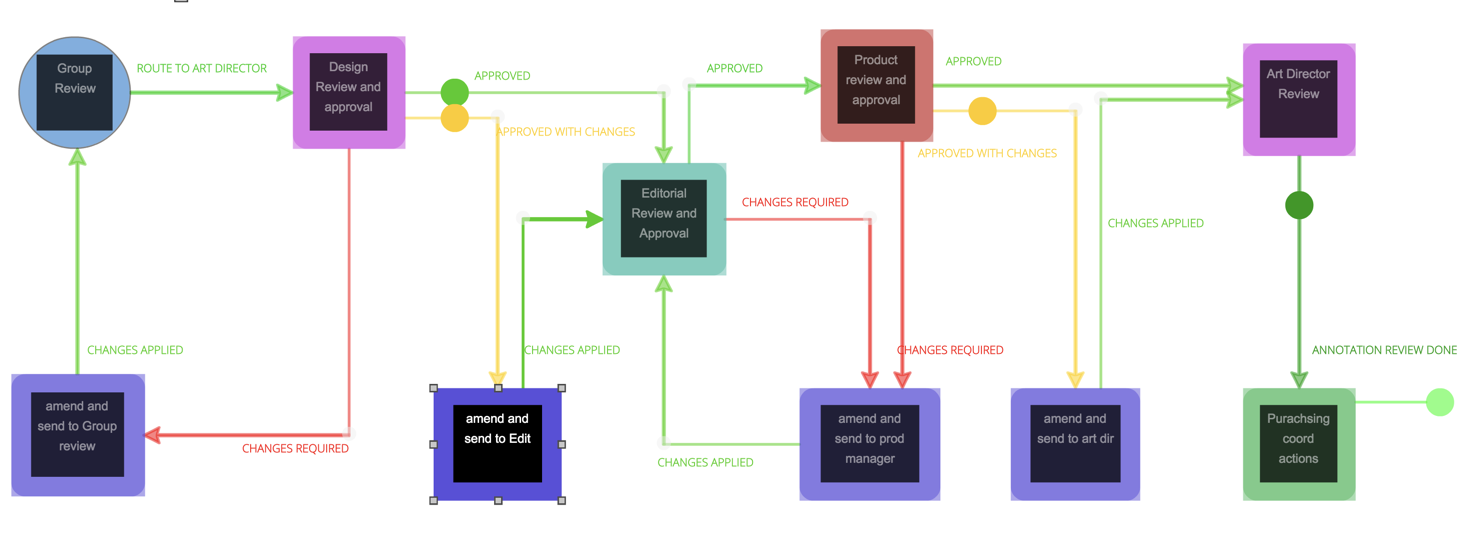Share this
Actionable Tips for Building & Optimizing a Marketing Approval Process
by Jeff Ross on March 11, 2022 8:20:29 AM EST
In any organization with a marketing department, the marketing approval process is often one of the essential workflows and one of the most challenging to optimize.
 The majority of marketers have admitted that approval delays are one of the top reasons they miss deadlines. So, whether an organization can streamline and optimize its marketing approval process will affect how efficiently the whole organization will perform.
The majority of marketers have admitted that approval delays are one of the top reasons they miss deadlines. So, whether an organization can streamline and optimize its marketing approval process will affect how efficiently the whole organization will perform.
On the other hand, many marketing leaders and marketing teams still rely on inefficient methods and techniques like emails, basic file-sharing systems (DropBox or Google Docs) that are not designed for approval workflows, and traditional project management systems, while in reality, today’s complex approval process demands more.
A centralized approach to managing marketing approval is crucial, and an organization will need the correct tools and strategies to streamline the whole approval process.
In this guide, we will show you the actionable steps for building and optimizing an efficient marketing approval workflow, and by the end of this guide, you’d have learned about:
-
The concept of a marketing approval workflow
-
Why it’s essential to have a streamlined and optimized workflow
-
Common challenges in the marketing approval process and how to tackle them
-
A step-by-step guide to building and optimizing an efficient marketing approval workflow
-
Best practices to follow to ensure the efficiency of the approval workflow
Marketing Approval Process: The Definition
First, what is a “process,” or more exact, “business process”?
A business process is just one out of three different types of workflows. We can define a “workflow” as a set of tasks or steps, typically sequential, that will accomplish a specific objective or objectives when executed.
As discussed, there are three different types of workflows based on their predictability and repeatability:
-
Process workflow: a workflow that has both predictable steps and is repeatable. For example, in a coffee shop, brewing an Americano is a process workflow.
-
Project workflow: a workflow with predictable steps but is not repeatable. With the same coffee shop example, inventing a new dish or drink is a project.
-
Case workflow: in a case workflow, the steps required to finish the workflow aren’t known (unpredictable) at first. Only when more information has been gathered that they’ll reveal themselves. A case workflow is also non-repeatable. Handling a customer complaint is an example of a case workflow.
So, what is a “marketing approval process”?
A marketing approval process, or marketing approval workflow, is a repeatable workflow of reviewing a marketing asset from ideation until the stakeholders approve it, so it’s eligible for a launch.
In practice, a marketing approval process requires thorough coordination between three parties:
-
Content creators: or creative workers like graphic designers, copywriters, videographers, digital marketers, etc.
-
Approvers: Marketing Managers, Creative Directors, CEOs, etc.
-
External stakeholders: vendors, suppliers, sponsors, brand partners, and clients, among others.
If the company is in an industry where marketing audits are legally required, a complete record of feedback, comment, revision requests, versions, actions taken, and sign-offs must be kept. In practice, this can be easier said than done without the right tools and the right strategy.
Why You Need To Optimize Marketing Approval Process
Designing and building a comprehensive marketing approval process and optimizing it to make sure it’s executed as efficiently as possible will ensure:

-
Everyone involved in the workflow is on the same page and understands how to perform the approval process. This will improve consistency.
-
Enabling marketers to analyze the whole approval process and identify bottlenecks to optimize the approval workflow further
-
Improve the transparency of the marketing approval workflow and accountability of everyone involved in the workflow. Every stakeholder can easily see the real-time progress of the ideation, content creation, and the approval process itself so they can make a better-informed decision on each step. Approvers will also better understand the project and deliverable, resulting in quicker approvals and fewer revision cycles.
When implemented and established correctly, a streamlined marketing approval process can offer the following benefits:
-
Ensuring a faster project delivery, no more missed deadlines.
-
Ensuring a centralized hub for managing the whole marketing approval process, saving time and effort needed to collect, share, and track the latest versions of deliverables
-
Maintaining a standardized and consistent approval process, reducing confusion and disputes.
-
Reducing or eliminating communication and collaboration delays, especially during revision cycles and revision requests
-
An easier time locating stakeholders and approvers
-
Real-time updates for the team and external stakeholders about the status of projects
-
Improve client satisfaction by consistently meeting or exceeding expectations
In the long run, implementing an optimized marketing approval workflow throughout your organization can significantly improve your team’s efficiency and productivity.
Challenges in Optimizing a Marketing Approval Workflow
It’s crucial to understand that a marketing approval process is very dynamic. Even a seemingly minor thing like a last-minute simple revision request to a design can cause many different issues that may affect the whole team.
There are also a lot of dynamic challenges you’re likely to face in a marketing approval workflow, and here are some of them:
Decentralized Approval Process
To ensure optimal execution of the marketing workflow process, everyone involved in the process should have equal (but authorized) access to assets to collaborate effectively.
However, without using a centralized workflow management system, this can be a significant issue. An average marketing team can now use more than ten decentralized apps and solutions.
For instance, let’s say that in the process of developing video content, you’ll have a copywriter using Microsoft Word, a videographer using Premiere Pro, and a graphic designer using Adobe CS. These tools are decentralized and can’t be natively integrated, so each content creator must first export their files and arrange access to them when it comes to the approval process.
For approvers, this decentralization can also be a challenge. What if only the copy needs rework, but the video and design are fine? How should an approver elaborate this as feedback? As a result of this decentralization, the marketing approval workflow may end up involving disjointed systems: one for managing schedules, tasks, and deadlines, and another for storing and sharing assets, version files, and feedback. This can be counterproductive in the long run.
A decentralized approval process can cause significant delays here and there, significantly reducing the overall efficiency of the process.
Inefficient Email-Based Collaboration
Many organizations still rely on emails for most of their communications and collaborations. While emails are still pretty effective in performing many different functions, it’s not an ideal communication tool for handling marketing approval processes due to several reasons:
-
When a marketing project involves a significant number of asset versions, it can be challenging to find a specific version in an email thread.
-
It can be challenging to control different team members and stakeholders when deciding whom to include or exclude when they reply or forward emails. Meaning email-based communication lacks transparency.
-
Feedback can potentially come too late with a lack of real-time notifications and reminders in email communications. Not only will they be irrelevant, but they can cause confusion.
-
Hard to keep track of who has opened an email and forgot to reply, which can delay the marketing processes.
-
Email feedback is not directly tied to the sent asset/file, so it can be difficult to trace
Difficulty in Tracing File Versions
 In a standard email-based collaboration or traditional project management tool without a dedicated version management/control function, it can be challenging to trace different file/asset versions throughout the whole marketing approval process.
In a standard email-based collaboration or traditional project management tool without a dedicated version management/control function, it can be challenging to trace different file/asset versions throughout the whole marketing approval process.
For instance, the approver may have difficulty recognizing which asset version is the most current one and may end up providing feedback on older asset versions, potentially creating unnecessary back-and-forth confusion and disputes.
Without proper version control, the whole marketing approval process can be confusing and frustrating for everyone involved in the workflow and can cause significant delays to the project.
It’s crucial to choose a workflow automation solution capable of managing the intricacies of versioning. For instance, Aproove keeps a comprehensive record of all feedback, replies, and attachments for different versions added to the project. As soon as a new asset version is deployed, the older version is locked immediately to prevent confusion.
Lack of transparency and Accountability
An important factor in streamlining a marketing approval workflow is transparency: ensuring everyone involved in the workflow can track the project's current status in real-time. However, with a decentralized marketing approval process, there will be a lack of transparency which will lead to the following issues:
-
Stakeholders can’t track who has reviewed and approved a deliverable. This may result in change requests and feedback that will slow down the project’s timeline.
-
You’ll have a hard time tracking asset/file versions, markups, annotations, and comments. This may confuse both content creators and approvers who are unsure which versions are currently being reviewed.
-
With a lack of transparency, content creators may spend too much time chasing feedback and approvals rather than creating and optimizing the marketing deliverable.
Disjointed Internal and External Approvers
If your marketing project involves external approvers (i.e., clients or sponsors), then the marketing approval process can be even more challenging.
There can be a significant disconnect between external and internal approvers throughout the marketing approval process. For instance, your client may enter the approval process before the asset has been approved internally, causing confusion and even disputes.
It’s crucial to have a marketing work management software like Aproove that facilitates a centralized and transparent dashboard where both internal and external reviewers can easily track and review progress together in real-time. This way, both internal and external stakeholders would be able to clearly understand the current status of the process and what actions they are still required to take.
Building and Optimizing Marketing Approval Workflow: Step-By-Step
While the process of building an ideal and optimized marketing approval process may vary depending on the organization’s structure, external stakeholders’ profiles, and other factors, here are the basic steps you can follow in building an efficient marketing approval process:
Step 1: Identifying Internal and External Stakeholders
 This first step might seem simple and obvious, yet it’s an essential foundation that shouldn’t be neglected.
This first step might seem simple and obvious, yet it’s an essential foundation that shouldn’t be neglected.
Identify your internal and (if any) external stakeholders, and clearly define their roles and responsibilities.
Your internal stakeholders can vary depending on the marketing activity and asset that will be reviewed. For example, if we are going to review and approve a graphic design work, the internal stakeholders might be a graphic designer and a creative director.
Consider the different departments in your organization when defining your internal stakeholders. For example, is there anyone in the finance or HR department that should be involved in the approval process? Sometimes the answer wouldn’t be so apparent at first.
Similarly, carefully consider who should be regarded as external stakeholders. If you are working for a client (i.e., a marketing agency or graphic design agency), who should be considered stakeholders in the client company?
Once you’ve listed all internal and external stakeholders, divide them based on their role and level of influence/responsibility. Identify high-level stakeholders so you can strategize the next steps accordingly.
A crucial thing in this step is ensuring each stakeholder understands their role, their responsibilities, and when they are expected to take the required actions (i.e., when a reviewer should review).
Step 2: Create an Approval Matrix
Based on the information you’ve gathered regarding the internal and external stakeholders of the workflow, you can start building an approval matrix.
An approval matrix is a comprehensive document listing the stakeholders (or their roles) who need to approve different activities/deliverables throughout the marketing approval process.
First, list all the activities, tasks, and associated deliverables that would occur in the specific marketing project, then identify who needs to approve each task. The higher the level of the stakeholder, typically the fewer items they’d need to approve. For example, a CEO obviously shouldn’t need to approve all social media posts.
The more detailed your approval matrix is, the more transparent the marketing approval workflow will be, and the more time you’ll be able to save.
Some tips regarding the approval matrix:
-
Ensure the approval matrix is stored in a centralized location (i.e., in a workflow management solution.) This is to ensure every stakeholder can easily see who approves what and the project's status.
-
The approval matrix is not a one-off thing. Keep it up-to-date. Reflect the status of the project, as well as when there's any change within your team
-
It's also crucial to identify who needs to be informed (but don't need to review/approve) in each process step. Document it in the approval matrix.
Step 3: Identifying The Stages of The Approval Process
The next step is to identify and map the stages in the marketing approval process.
If your workflow has external stakeholders, then we’d recommend creating separate maps for your internal and external review stages. This is to ensure you can optimize and streamline each process appropriately without interfering with each other.
When mapping the different stages of the approval workflow, consider the following:
-
The goal of mapping these stages is to ensure that approvers (both internal and external) receive deliverables correctly. This is to ensure the project stays within the deadline.
-
Which comments or asset versions should be internally approved, externally approved, or both.
-
What are the most crucial approval details for the asset you want to spot quickly?
-
What type of content should be segmented?
-
How to design the stages efficiently to help your creative team stay productive?
Step 4: Map a Workflow Diagram

Now that you’ve defined the details of your approval workflow, you can start mapping the marketing approval process into a workflow diagram. You can use many methods, and you can even start with just a pen and paper. However, the standard method is to use an ANSI flowchart. If your workflow management solution has a built-in workflow builder, you should easily create a flowchart workflow diagram with it.
Here are a few considerations:
-
Map out the approval workflow as-is (as it is currently executed), and focus on accuracy.
-
Define each review stage (as you’ve identified in the previous step), and identify the approver(s) for each stage.
-
Communicate clear instructions for approvers on what they should give feedback on, as well as when you need the review/approval to be given. Communicate your timeline/deadline clearly.
-
Instruct your approver clearly on how to give their feedback.
The more complete and accurate your workflow diagram is, the easier you can analyze and optimize the workflow for efficiency, so don’t underestimate the importance of this step.
Step 5: Manage Authentication and Access At Each Review Stage
Once you’ve established the workflow diagram, you can establish authentication and access control at each approval stage. This is especially important if your process involves many different stakeholders to prevent disputes at each stage. Even a single conflicting opinion can significantly slow down the approval process, so you’d want to minimize this as much as possible.
When considering whether a potential approver is needed at each stage, consider:
-
Availability: will they be available at the time needed by the project’s timeline
-
Qualification: are they qualified for reviewing the specific aspect of the workflow
-
Motivation: are they willing to provide useful feedback timely?
-
Creativity: will this potential approver has the potential of covering a different/fresh angle of the process
In general, only include a potential approver when required to minimize hiccups. More people means more possibilities of disputes and more revision cycles, which can also add to more issues regarding version tracking.
Try to keep the number of approvers lower than three people per stage. Limit only one approver per stage if possible to minimize contradictory feedback.
Step 6: Optimize The Approval Workflow
A key approach in optimizing an approval workflow is to minimize the number of revisions as much as possible.
Analyze the workflow diagram to identify bottlenecks and inefficiencies, and plan the steps to minimize or eliminate these inefficiencies.
Specific to the approval process, try to keep the number of revision cycles as low as possible, and not more than two: one revision round to implement changes according to the feedback, and another for signing off. Minimizing the number of revisions can encourage approvers to make the most of their feedback and shorten the project execution time.
Here are a few tips:
-
Again, keep the number of review cycles to two whenever you can and not more than three rounds.
-
Have a clear system to label and track asset versions
-
In general, make sure the asset is approved internally first before it goes to external approvers. This can streamline the process significantly and eliminate the need of going back and forth.
Step 7: Keeping an Audit Trail
The last (but not least) step is establishing a system to keep an audit trail of the entire marketing approval workflow. Maintaining a comprehensive audit trail may also be legally required for compliance, depending on your industry.
-
For assets or file formats that are challenging (i.e., videos), create templates for approval to make sure no details will be missed
-
Make sure all visual assets are reviewed in a single place.
-
Store all approved assets in a centralized hub that is searchable, so it’s easy to find and use any asset.
Wrapping Up
An optimal and streamlined marketing approval process can significantly improve your marketing team’s efficiency and productivity. A simplified approval workflow will effectively reduce delays in collaboration and accelerate project delivery timelines while maintaining quality.
If you want to improve your marketing approval process with modern workflow management and online proofing systems, get started with Aproove today.
Share this
- Featured (23)
- Educational (22)
- New Release (21)
- Online Proofing (20)
- Workflow Management (19)
- Project Management (18)
- Work Management (17)
- Business Workflow (16)
- Newsletter (15)
- BPM Software (10)
- Business Automation (8)
- Workflow Automation (8)
- Marketing Workflow (7)
- Digital Asset Management (6)
- Industry News (6)
- News (6)
- business process workflow (5)
- Marketing management (4)
- BPM (3)
- Marketing Automation (3)
- Task Management (3)
- AI (1)
- Aproove news (1)
- Case Studies (1)
- Case Study (1)
- DAM Software (1)
- Document Management Automation (1)
- Document Workflow Automation (1)
- Insider (1)
- enterprise project management (1)
- insurance work management (1)
- marketing process (1)
- July 2024 (8)
- June 2024 (11)
- May 2024 (6)
- April 2024 (7)
- March 2024 (7)
- February 2024 (6)
- January 2024 (4)
- December 2023 (3)
- November 2023 (7)
- October 2023 (7)
- September 2023 (3)
- August 2023 (5)
- July 2023 (3)
- June 2023 (1)
- May 2023 (1)
- April 2023 (1)
- February 2023 (2)
- September 2022 (3)
- August 2022 (1)
- July 2022 (1)
- May 2022 (1)
- March 2022 (3)
- February 2022 (3)
- January 2022 (3)
- November 2021 (2)
- October 2021 (2)
- September 2021 (1)
- August 2021 (4)
- July 2021 (4)
- June 2021 (2)
- May 2021 (3)
- April 2021 (1)
- February 2021 (1)
- November 2020 (1)
- October 2020 (2)
- July 2020 (4)
- June 2020 (2)
- May 2020 (2)
No Comments Yet
Let us know what you think